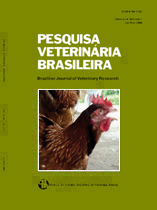 |
|
|
|
Year 2013 - Volume 33, Number 5
|

|
Anatomical techniques in the animal anatomy practice teaching, 33(5):688-696
|
ABSTRACT.- Cury F.S., Censoni J.B. & Ambrósio C.E. 2013. [Anatomical techniques in the animal anatomy practice teaching.] Técnicas anatômicas no ensino da prática de anatomia animal. Pesquisa Veterinária Brasileira 33(5):688-696. Departamento de Medicina Veterinária, Faculdade de Zootecnia e Engenharia de Alimentos, Universidade de São Paulo, Av. Duque de Caxias Norte, Pirassununga, SP 13635-000, Brazil. E-mail: ceambrosio@usp.br
The concern about preservation of anatomical specimens in existence for over 5000 years, since the use of anatomical parts, are indispensable for teaching and contribute for the improvement of applicative, assimilative skills and understanding of the discipline. This paper proposes better use of techniques in anatomy laboratories, to abolish the use of formaldehyde as preservative, allowing a pleasant environment for the practice of teaching/learning relationship. For this purpose, we used four anatomical techniques, (1) the cryodehydration, (2) glycerin conservation, (3) latex injection and (4) vinylite injection followed corrosion, we executed using dogs, cats and organs from donations. With cryodehydration and glycerin conservation the anatomical materials were considerably lighter than when kept in formaldehyde, odorless unlike in the use of formaldehyde and other preservatives. The structures to be studied were kept intact, easily to view, and the specimens could be stored in closed boxes without any liquid, thus remaining for up to 3 years. The Injection techniques (latex and vinylite followed by corrosion) showed total efficiency to inject filling systems, and allowed a clear view of all ramifications and paths of the circulatory system. The four anatomical techniques studied were shown to be sufficient to meet the needs of students to study anatomy due to the perfect disclosure of external and internal animal structures. |
| |
|
|
| |
|
 |